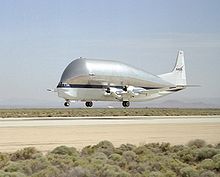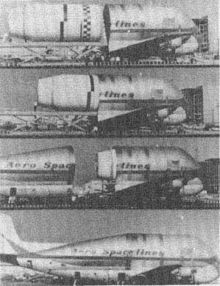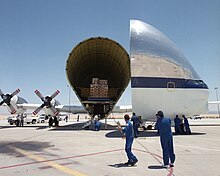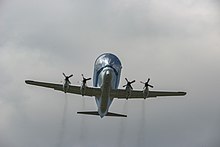Guppy (airplane)
As Guppy rebuilds are planes of type Boeing 377 Stratocruiser and Boeing C-97 Stratofreighter denotes that stand by an increase of the hull. They were carried out by the US company Aero Spacelines (first in Van Nuys near Los Angeles, then in Santa Barbara , also in California) and by UTA Industries based in Le Bourget (France) . The width and height of the cargo hold are even slightly larger than the Airbus Beluga , but the length of the cargo hold is significantly shorter. The aircraft got their name from a fish: Guppies are viviparous fish that have a significantly inflated belly during pregnancy - thus associations between the aircraft and this species of fish resulted, which led to the name of the aircraft. Since 1998 only one copy has been active (at NASA ).
history
The former military pilot John Conroy, together with the aircraft dealer Lee Mansdorf, founded the company Aero Spacelines in 1961 .
When NASA began to plan ever larger rocket parts, it quickly became clear that these could only be meaningfully transported by air. NASA commissioned Aero Spacelines to convert some of the decommissioned Boeing 377 Stratocruisers. The Boeing 377 was the civil version of the C-97 Stratofreighter, a development based on the Boeing B-29 bomber .
When designing the C-97, basically only the fuselage was redesigned and the propulsion system changed, but the wing and tail units were taken over from the B-29. From the seventh machine onwards, the vertical stabilizer and the engines of the Boeing B-50 Superfortress were used.
The military C-97 Stratofreighter was built in 77 copies; 811 of the KC-97 tanker version were added . Only 56 aircraft of the Boeing 377 civil passenger aircraft were produced, most of which were retired at the end of the 1950s. Some of these machines, most of which were in very good condition and had only a few flying hours, were used for the guppy conversions.
The guppy conversions can be divided into three series called Pregnant Guppy, Super Guppy and Mini Guppy.
Airbus has long used Super Guppy aircraft to transport aircraft parts between European manufacturing facilities. However, the company now uses a similar type of aircraft that it designed itself, the Airbus Beluga (A300-600ST) . A copy of the Super Guppy is in the Airbus plant in Hamburg-Finkenwerder .
To transport the parts for the Boeing 787, Boeing developed its own transport machine based on converted 747-400 passenger aircraft . The Boeing 747 Large Cargo Freighter (747 LCF) (also called Dreamlifter , based on the marketing name Dreamliner of the 787) was developed by Boeing together with the Taiwanese Evergreen Aviation Technologies Corporation (EGAT) . EGAT is solely responsible for the conversion, while the completed aircraft were initially operated by Evergreen International Airlines (a US company with no ties to the Evergreen Group) and since 2010 by Atlas Air .
Pregnant guppy
B-377PG ( Pregnant Guppy ): 1 built copy.
On Mark Engineering (also in Van Nuys), founded in 1954, converted a B-377 into a rocket transporter on behalf of Aero Spacelines; the latter had designed the conversion. The machine was a former Pan Am passenger aircraft ( registration number N1024V , serial number 15924). This first version was called the Pregnant Guppy and took off on its maiden flight on September 19, 1962.
During the conversion, the Stratocruiser hull was lengthened by 5.08 m in the rear section and the upper hull shell was replaced by a new design with a larger diameter. This raised the cargo hold height from originally 2.74 m to 6.20 m. The conversion was finally completed in the spring of 1963 after a test flight time of 60 hours, after it had been shown that the machine was stable and controllable in all flight conditions. Only then was the upper part of the original fuselage removed within the newly constructed larger shell and the rear fuselage section designed as a removable element.
The entire tail area with the vertical stabilizer could be separated from the fuselage so that the large launch vehicle stages for the American space agency NASA can be loaded without any problems. Until its retirement, it served NASA as a transporter. The first built now serves as a spare parts store for the last built. The special feature of this model, in addition to the smaller loading volume compared to the Super Guppy, was the removable stern via which the cargo was loaded.
Super guppy
B-377SG-201 ( Super Guppy ): 1 built copy.
The Super Guppy (SG-201) made its maiden flight on August 31, 1965. It was even larger and had a turboprop engine , consisting of four T34 propeller turbines (Pratt & Whitney T-34P7), while the Pregnant Guppy was still powered by piston engines. The hull length was increased to 43.05 m, the cargo hold height to 7.77 m.
The construction and the associated need to transport the new Saturn V rocket stages ( Apollo program ) made the construction of this huge transporter necessary. After the renovation, it was possible to load a maximum of 18.6 tons. At NASA, this aircraft had the registration number NASA 940 and flew among others for NASA's Gemini , Apollo , Space Shuttle and Skylab programs.
In 1990 it was decommissioned by NASA , flown to Davis-Monthan Air Force Base near Tucson , Arizona in July 1991 and is now on display in the adjacent Pima Air & Space Museum .
Awesome guppy turbine
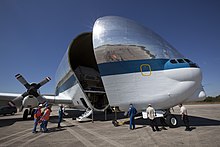
B-377SGT-201 ( Super Guppy Turbine ): 4 units built
A direct further development was the Super Guppy Turbine (SGT-201), of which two units were initially built, which made their maiden flights on August 24, 1970 (N211AS) and August 24, 1971 (N212AS). The Super Guppy Turbine was the same size as the Super Guppy, but was powered by four Allison 501-D22C propeller turbines. This enabled a maximum payload of 25 t. After the Apollo program was discontinued, both SGT-201 were sold in November 1971 (F-BTGV) and August 1973 (F-BPPA) to the French company Aéromaritime , which they used for the transport of large components between the aircraft manufacturer Airbus various manufacturing centers and Toulouse used. Airbus Industries acquired the manufacturing rights and technical documentation for the SGT-201 and had the Le Bourget- based company UTA Industries manufacture two more aircraft. The machines were handed over to Aéromaritime in July 1982 (F-GDSG) and July 1983 (F-GEAI). At the same time as the delivery of the third aircraft, the machines were given their characteristic paintwork with the Airbus Skylink logo on the fuselage.
In 1989 the newly founded Airbus subsidiary Airbus Inter Transport took over the four aircraft from Aéromaritime and operated them until 1998. They have since been replaced by the Airbus A300-600ST Beluga .
Three of the four SGT-201 have been kept as museum aircraft since their decommissioning: two at the main locations of the Airbus project in Toulouse-Blagnac and Hamburg-Finkenwerder and one at Bruntingthorpe airfield (England). The fourth machine, the former Airbus Transporter 04 built in France in 1983 , was acquired by NASA in 1997 and is still in service for them (as of 2018). NASA used the aircraft under the designation NASA 941 ( Silver Hump ), among other things, to transport modules for the International Space Station (ISS). A special bracket, the Super Guppy Shipping Fixture , was developed for this purpose, which is modeled on the payload bay of the Space Shuttle.
Around 20 years later, NASA is still using this last copy, especially in its role in the revival of the independent manned space flight of the USA after the space shuttle program was discontinued : One of the regular functions of the SGT is to long-term the individual modules of the Orion Spaceship between New Orleans (manufacturing), u. a. the Glenn Research Center in Ohio (testing) and the Kennedy Space Center in Florida (final assembly and launch).
Technical specifications
- Span: 47.61 m
- Length: 46.84 m
- Height: 14.85 m
- Engines: 4 × Allison 501 D22C with 3610 kW
- Empty weight: 45.8 t
- Max. Takeoff weight: 77.1 t
- Payload: 24.5 t
- Crew: 3
- Speed: 460 km / h; economic cruising speed: 407 km / h
- Summit height: 7620 m
- economic range: 813 km
Mini guppy
B-377MG ( Mini Guppy ): 1 built copy.
The original Pratt & Whitney R-4360 Wasp Major engines were retained during the modifications . A swiveling rear was installed for this. After the renovation work, a maximum payload of 14.5 tons was possible.
- First flight on May 24, 1967
- Owner of Aero Spacelines (until 1974), American Jet Industries (until 1980), Aero Union (until 1988), Erickson Air Crane (until 1995). It is now in the Tillamook Air Museum in Tillamook , Oregon .
Mini guppy turbine
B-377MGT-101 ( Mini Guppy ): 1 built copy 1) (registration number N111AS , serial number 0001).
In this variant, the same Allison 501-D22C engines with four-bladed propellers were installed as in the Super Guppy turbine, the fuselage was lengthened by 81 centimeters compared to the Mini Guppy and widened by 5 centimeters and a pivoting nose was installed. After the modifications, it had a maximum payload of 28.6 tons.
- First flight March 13, 1970
- Crash during flight tests at Edwards Air Force Base , California (USA) on May 12, 1970.
1) According to Bowers , a second Mini Guppy turbine was built (registration number N112AS , serial number 0002); However, no further evidence of this has yet been found.
See also
Web links
- Robert S. Tripp: Pregnant Guppy. The strange epic of the ugly airplane that got us to the moon. In: American Heritage of Invention and Technology. Issue 4, 2002.
- All about guppies
Individual evidence
- ↑ Peter M Bowers : Boeing Aircraft since 1916. Putnam Aeronautical Books, London 1989, pp. 370–374, ISBN 0-85177-804-6 .
- ↑ Martin Bach: Boeing 367 Stratofreighter, Boeing 377 Stratocruiser, Aero Spacelines Guppies. NARA Verlag, Allershausen 1996, p. 52, ISBN 3-925671-18-8 .
- ↑ Gordon Swanborough and Peter M Bowers: United States Military Aircraft since 1909. Putnam Aeronautical Books, London 1989, pp. 125–127, ISBN 0-85177-816-X .
- ^ John WR Taylor: Jane's All The World's Aircraft, 1963-1964. Sampson Low, Marston & Company, London 1964, pp. 258-260.
- ^ John WR Taylor (Ed.): Jane's All The World's Aircraft - 1965-1966 , Sampson Low, Marston & Company Ltd., London, 1965, p. 282
- ↑ John WR Taylor: Jane's All The World's Aircraft, 1971-1972. Jane's Yearbooks, London 1972, p. 218.
- ↑ Bach, p. 56
- ↑ jp airline-markings, issues 72 and 73
- ↑ Aero, edition 46/1988
- ↑ jp airline-fleets international Edition 92/93
- ↑ jp airline-fleets international, Edition 97/98
- ↑ B377PG Super Guppy. NASA, March 25, 2013, accessed December 2, 2018 .
- ↑ Super Guppy Shipping Fixture has new home. (PDF; 1.0 MB) In: Space CenterRoundup Vol. 39, No. June 13, 30, 2000, accessed January 3, 2019 .
- ↑ NASA's Deep Space Exploration System is Coming Together. NASA, March 8, 2019, accessed March 11, 2019 .
- ↑ European Service Module-Structural Test Article Load onto Guppy. NASA, June 23, 2017, accessed December 2, 2018 .
- ↑ Super Guppy Ready to Transport the Orion Spacecraft. NASA, February 1, 2016, accessed December 1, 2018 .
- ↑ NASA's Super Guppy Gives Mars-Bound Spacecraft A Lift. In: techcrunch.com. February 1, 2016, accessed December 1, 2018 .
- ↑ Taylor 1971-1972, pp. 218-219
- ↑ Bowers, p. 374
